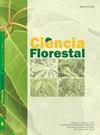Analytical study of the dimensional stability of tropical brazilian wood species
IF 0.5
4区 农林科学
Q4 FORESTRY
引用次数: 1
Abstract
Brazil owns a large vegetal covering and the best utilization of these materials requires physical and mechanical characterization procedures. Equations found in the literature make easier the wood properties determination. At this context, well known authors developed the equation βl = βt/23, being βl and βt the longitudinal and tangential shrinkage percentages, for βl estimation based on the βt value specially for wood species from the Northern hemisphere. This paper aims to investigate the accuracy of this equation for fifteen tropical Brazilian wood species covering the entire range of hardwood strength classes according to the Brazilian Normative ABNT NBR7190. The average experimental values of βl and βt were 7.71% (CV = 26,71%) and 0.73% (CV = 38,76%), respectively. The non-parametric Kruskal-Wallis ANOVA refuted the hypothesis of equivalence between theoretical and experimental βl values (p-value = 0.0000). A linear regression model fitted to experimental values provided βl = βt/9,84 as optimal solution (p-value = 0.0000, R2 = 47,23%). According to results it is possible to conclude that the value of longitudinal shrinkage percentage of tropical Brazilian wood species is statistically 2,34 times greater than the value found in the literature, which impacts the design of timber structures procedures increasing the internal stresses in timber structural elements.巴西热带树种尺寸稳定性的分析研究
巴西拥有大量的植物覆盖物,这些材料的最佳利用需要物理和机械表征程序。文献中的方程式使木材性能的确定更加容易。在这种情况下,著名的作者开发了方程βl=βt/23,其中βl和βt是纵向和切向收缩百分比,用于基于βt值来估计βl,特别是针对北半球的木材物种。本文旨在根据巴西规范性文件ABNT NBR7190,研究覆盖所有硬木强度等级的15种巴西热带木材的该方程的准确性。βl和βt的平均实验值分别为7.71%(CV=26,71%)和0.73%(CV=38,76%)。非参数Kruskal-Wallis方差分析驳斥了理论和实验βl值相等的假设(p值=0.0000)。拟合实验值的线性回归模型提供了βl=βt/9,84作为最优解(p值=0.000,R2=47,23%)。根据结果,可以得出结论,巴西热带木材物种的纵向收缩率值在统计上是文献中发现的值的2.34倍,这影响了木材结构程序的设计,增加了木材结构元件中的内应力。
本文章由计算机程序翻译,如有差异,请以英文原文为准。
求助全文
约1分钟内获得全文
求助全文
来源期刊

Ciencia Florestal
农林科学-林学
CiteScore
0.80
自引率
0.00%
发文量
85
审稿时长
18-36 weeks
期刊介绍:
The journal Forest Science was established in 1991 with the goal of being a vehicle for dissemination which are published works tércnico-scientific forest-related, the following bodies crowded the Centro de Ciências Rurais of Universidade Federal de Santa Maria:
- Centro de Pesquisas Florestais - CEPEF
- Programa de Pós-graduação em Engenharia Florestal - PPGEF
- Departamento de Ciências Florestais - DCFL
MISSION:
Publish scientific papers, technical notes, and literature reviews related to the area of forest sciences.
 求助内容:
求助内容: 应助结果提醒方式:
应助结果提醒方式:


